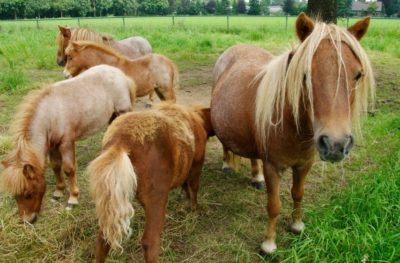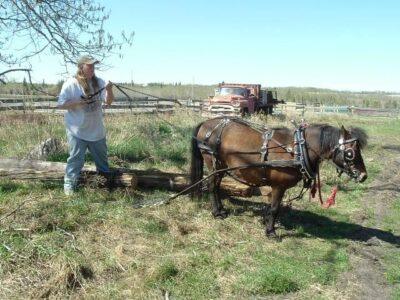 You’re out in the country one day and happen by a field of horses. With the horses is one lone pony. He tosses his head, his eyes and stocky neck covered by a long shaggy mane. An adorable pony nose peaks out from behind his heavy forelock. He sets off towards you with a perky little trot and before you know it, a velvety nose pokes through the wooden fence and nuzzles your hands. He pinches your fingers with his teeth, tosses his head and trots off, and you smile at his impishness.
You’re out in the country one day and happen by a field of horses. With the horses is one lone pony. He tosses his head, his eyes and stocky neck covered by a long shaggy mane. An adorable pony nose peaks out from behind his heavy forelock. He sets off towards you with a perky little trot and before you know it, a velvety nose pokes through the wooden fence and nuzzles your hands. He pinches your fingers with his teeth, tosses his head and trots off, and you smile at his impishness.
The Shetland pony’s cheekiness is only rivaled by its strength. Whereas draft horses can be expected to pull about half their body weight, Shetland ponies can handle twice their body weight. These hardy ponies used to be kept as work ponies, but with our communities now replete with modern conveniences, their usefulness on the homestead has been overlooked.
Shetland ponies were bred in the Shetland Isles. Forage was hard to come by and weather conditions were harsh. Short, stocky breeds survived where other types of horses died out. The ponies developed into hardy, easy keepers with long, double-coated winter coats. They had a “can-do” attitude, an adorable pony face, and just enough impishness to make people take them seriously.
Finding Your Shetland Pony
When you’re looking to acquire your first pony, you can look at local ads in your paper and online. Shetland breeders are another excellent source. Shetland ponies come in several different types; look for the stockier, draft-style types (sometimes known as traditional or UK types) as these are better suited for draft work. Stay away from auctions. Though you may be able to get a pony for a steal, there is usually a reason they are there, like soundness issues, bad temperament, or a horse that is completely green (not trained). Disreputable sellers mask these issues by drugging the animal before the auction. Once you find a pony you like, preferably well-trained (to ride and in harness if those are your needs) and sweet-tempered, arrange a visit for the vet to come out and look over the animal. The expense may be a little daunting, but veterinarians can catch soundness issues that you could easily miss. When choosing a working animal, this step is of the utmost importance. Not all sellers will be willing, but ask if you can take the pony on a trial basis, for a couple days to a week. Sign a contract and bring your new homestead helper home!
Feeding And Caring For Your Pony
Shetland ponies are easy keepers and don’t tend to be that expensive to feed. Stay on top of worming and vet visits and have a farrier out periodically to keep your pony’s hooves trimmed and in good condition. You’ll also need to watch your pony’s feed intake as Shetland ponies have a tendency to put on excess weight. Depending on the size and quality of your pasture, you may need to supplement with hay. Choose hay that is green and dry, but neither dusty nor moldy. Be sure to keep their grain securely stored, so they cannot accidentally get into it and founder, a crippling and often deadly result of eating too much grain at one time or being overweight.
Become more self-sufficient and create a more authentic life for yourself and your family!
Invest in quality horse fencing and have a run-in or stable ready for your pony so it can get out of the rain, snow and intense sun if needed. While Shetland ponies were developed in harsh conditions, they appreciate shelter from the elements, especially if there are no trees or other natural shelters around. Your pony will also need some form of companionship. On a homestead, there are likely to be other animals about, so this probably won’t be a problem, but consider bringing two ponies home or adding a goat to your pony’s enclosure. This will go a long way toward keeping your pony happy and healthy (loneliness adds stress to an animal’s life which directly affects its health and working abilities).
While it’s not hard to train a pony to pull, if not done correctly, bad habits can develop which can be very difficult to break. Shetland ponies tend to have a stubbornness streak, too, so it’s best to leave their initial training to an experienced trainer when you’re first starting out. Either purchase an already-trained animal and ask the previous owner to give you a few lessons on handling your new homestead partner, or invest in hiring a trainer to get you both started. If your pony will be doing double duty as a riding animal for your children, you’ll want to follow the same guidelines. Choose an already-trained animal or invest in some professional training before allowing your children to get on.
Shetland Ponies Have Multiple Uses
Shetland ponies can make excellent companions to other livestock and horses. They’re easy keepers and considerably less expensive to keep than larger horses. They also tend to be sweeter and more personable than donkeys.
They work well as a children’s first ride. However, adult supervision is essential; Shetland ponies are very smart and can develop bad habits when handled exclusively by children. Many Shetland ponies can carry smaller adult riders (130 pounds or less) if asked.

Image source: mcleodcreekfarm.com
Shetland ponies excel at pulling carts and can be put to use hauling and doing some field work. These ponies were originally used to haul peat for fuel and do farm work. Their stocky little bodies and work ethic made them particularly suited for this. When labor laws no longer allowed women and children to work in the mines, Shetland ponies became the beast of choice. They spent their entire lives in the mines. Although a sobering thought, it is a testament to their calm nature and willingness to work. With this history, Shetland ponies are naturally suited for farm work, hauling, plowing and pulling carts. They also work well as pack animals.
Finding Equipment
You’ll most likely need a well-fitting pony harness and a cart for basic homesteading work. You can purchase the harness used or new from your community, tack shops or online venues. Check wear and tear and mend a used harness as needed. It is essential that the harness fit properly, so spend some time adjusting it. An improperly fitted harness can rub a pony, leaving sore spots and make them unwilling to work for you in the future. Improperly fitted harnesses can also create longer lasting problems, like excessive wear and tear on joints leading to arthritis and a shorter working lifespan for your pony.
If you’re handy, you may be able to construct a simple cart for hauling, but it is generally recommended to purchase a cart designed for ponies, especially when you’re starting out. Sometimes used carts are available for considerable savings and these can be fixed up and painted to look quite charming.
If you want to progress beyond hauling, you can find field equipment, like plows, disks and graders for ATVs that can be configured to work with ponies. Consider adding another pony or two to your team and they may be able to manage a one-horse plow. Experiment, talk to other pony owners and explore options. You may discover that owning a Shetland pony is like opening a bag of potato chips. You can never have just one.
Shetland ponies are easy keepers and very strong for their size. Today’s animals come from a legacy of ready and willing working ponies. These smart and spunky ponies seem custom made for the homestead farm!
Sign up for Off The Grid News’ weekly email and stay informed about the issues important to you
 Off The Grid News Better Ideas For Off The Grid Living
Off The Grid News Better Ideas For Off The Grid Living




